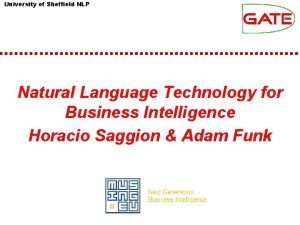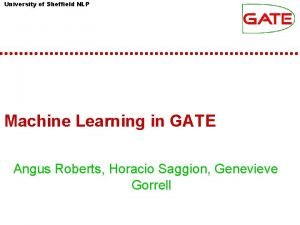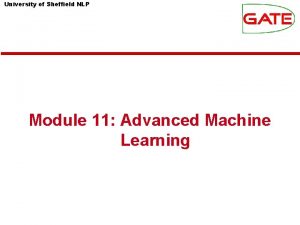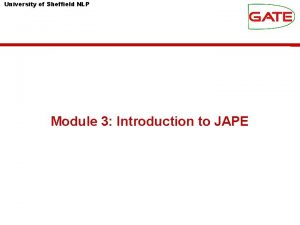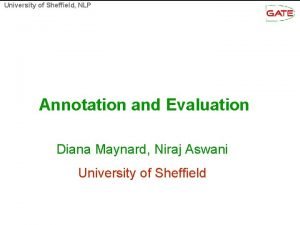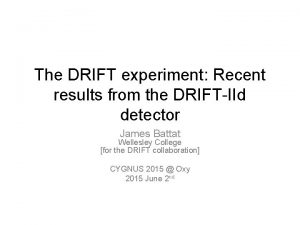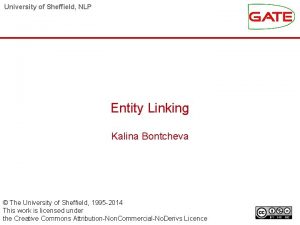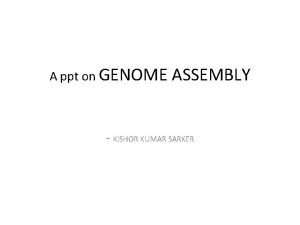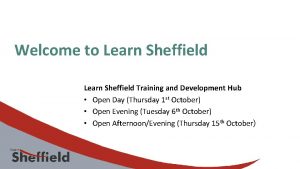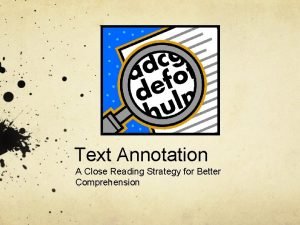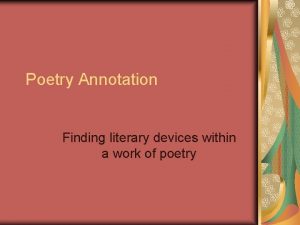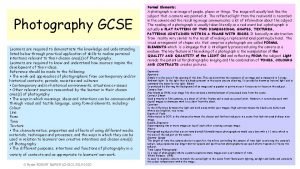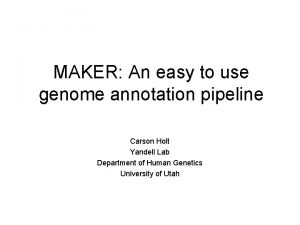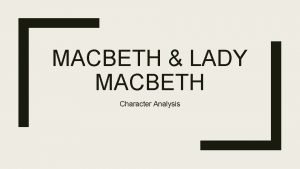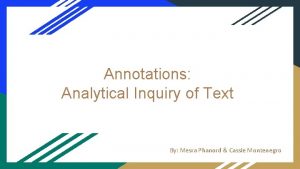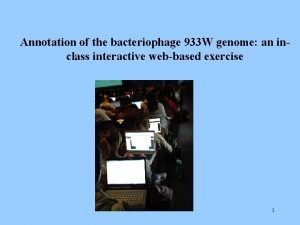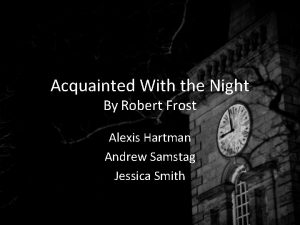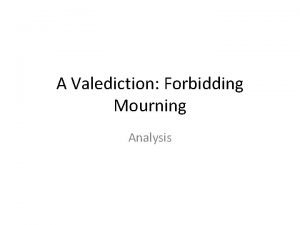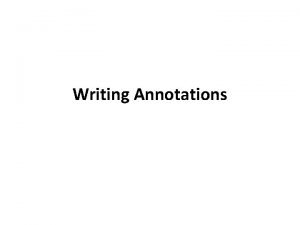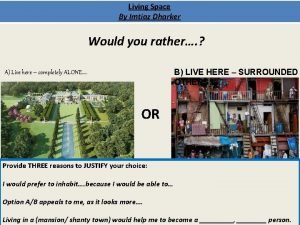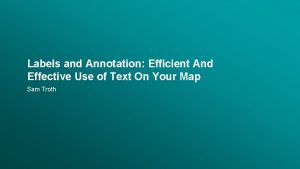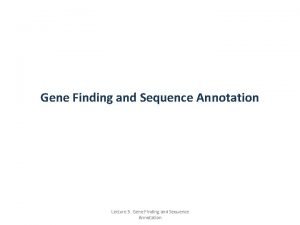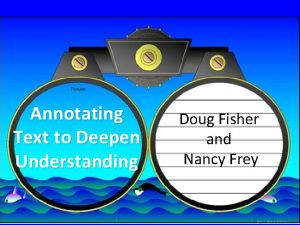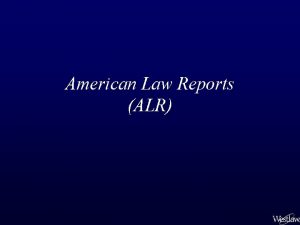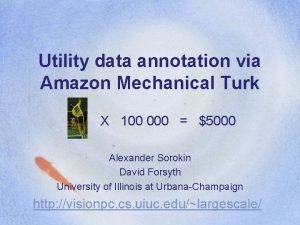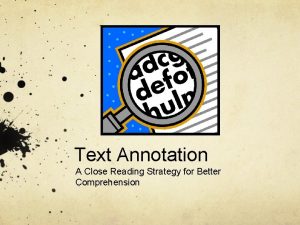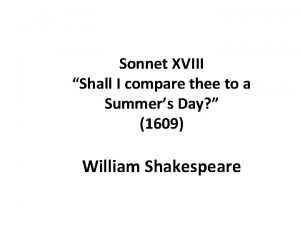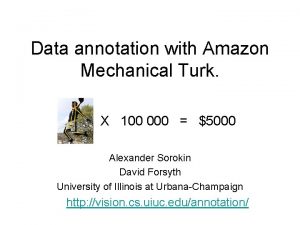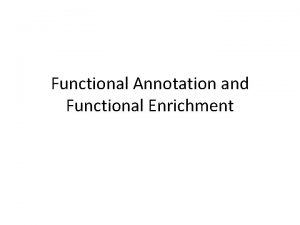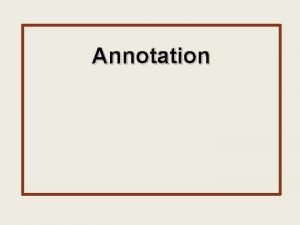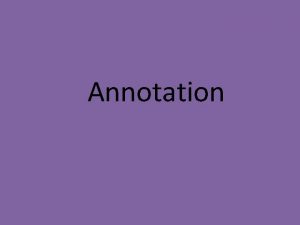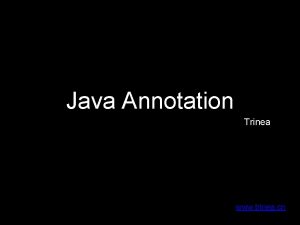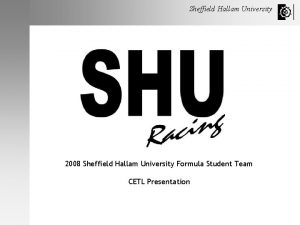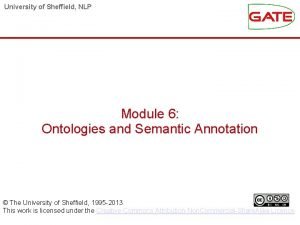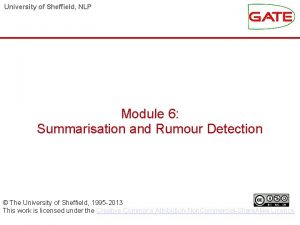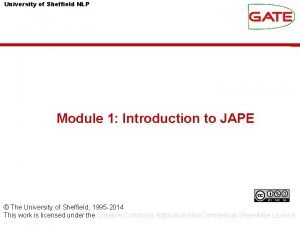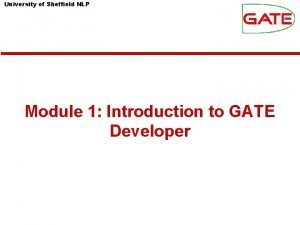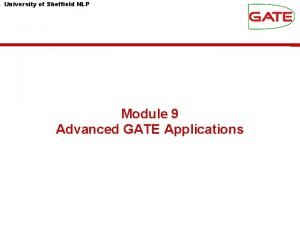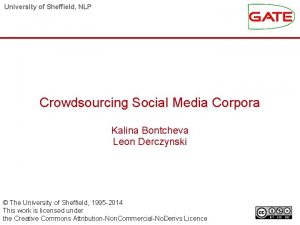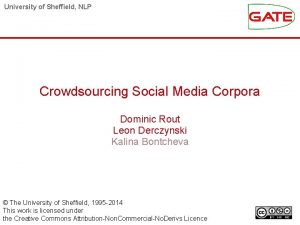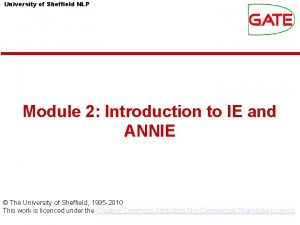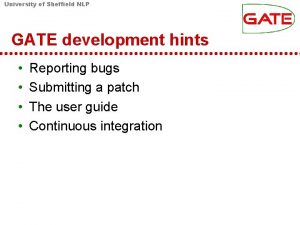University of Sheffield NLP Annotation and Evaluation Diana


































- Slides: 34

University of Sheffield, NLP Annotation and Evaluation Diana Maynard, Niraj Aswani University of Sheffield

University of Sheffield, NLP Topics covered • Defining annotation guidelines • Manual annotation using the GATE GUI • Annotation schemas and how they change the annotation editor • Coreference annotation GUI • Methods for ontology-based evaluation: BDM • Using the GATE evaluation tools

University of Sheffield, NLP The easiest way to learn… … is to get your hands dirty!

University of Sheffield, NLP Before you start annotating. . . • You need to think about annotation guidelines • You need to consider what you want to annotate and then to define it appropriately • With multiple annotators it's essential to have a clear set of guidelines for them to follow • Consistency of annotation is really important for a proper evaluation

University of Sheffield, NLP Annotation Guidelines • People need clear definition of what to annotate in the documents, with examples • Typically written as a guidelines document • Piloted first with few annotators, improved, then “real” annotation starts, when all annotators are trained • Annotation tools may require the definition of a formal DTD (e. g. XML schema) – What annotation types are allowed – What are their attributes/features and their values – Optional vs obligatory; default values

University of Sheffield, NLP Manual Annotation in GATE

University of Sheffield, NLP Annotation in GATE GUI (demo) • • • Adding annotation sets Adding annotations Resizing them (changing boundaries) Deleting Changing highlighting colour Setting features and their values

University of Sheffield, NLP Annotation Hands-On Exercise • Load the Sheffield document hands-on-resources/evaluation-materials/sheffield. xml • Create Key annotation set – Type Key in the bottom of annotation set view and press the New button • Select it in the annotation set view • Annotate all instances of “Sheffield” with Location annotations in the Key set • Save the resulting document as xml

University of Sheffield, NLP Annotation Schemas Define types of annotations and restrict annotators to use specific feature-values –e. g. Person. gender = male | female • Uses the XML Schema language supported by W 3 C for these definitions <? xml version=” 1. 0”? > <schema xmlns=”http: //www. w 3. org/2000/10/XMLSchema”> <element name=”Person”> <complex. Type> <attribute name=”gender” use=”optional”> <simple. Type> <restriction base=”string”> <enumeration value=”male”/> <enumeration value=”female”/> </restriction> </simple. Type>. . . <Person gender=male/>

University of Sheffield, NLP Annotation Schemas Just like other GATE Components Load them as language resources Language Resource → New → Annotation Schema Load them automatically from creole. xml <resource> <name>Annotation schema</name> <class>gate. creole. Annotation. Schema</class> <autoinstance> <param name="xml. File. Url" value="Address. Schema. xml" /> </autoinstance> </resource> New Schema Annotation Editor DEMO

University of Sheffield, NLP Annotation Schemas Hands-on-Exercise Load evaluation-material/creole. xml Load the Address. Schema. xml schema Load the Schema Annotation Editor Load the Sheffield. xml document Explore the Schema Editor Change creole. xml to load Address. Schema. xml automatically?

University of Sheffield, NLP Coreference annotation • Different expressions refer to the same entity – e. g. UK, United Kingdom – e. g. Prof. Cunningham, Hamish Cunningham, H. • Orthomatcher PR – co-reference resolution based on orthographical information of entities – Produces a list of annotation ids that form a co-reference chain – List of such lists stored as a document feature named “matches”

University of Sheffield, NLP Coreference annotation DEMO

University of Sheffield, NLP Coreference annotation Hands-on-Exercise Load the Sheffield. xml document in a corpus and run ANNIE without Orthomatcher Open document and go to the Co-reference Editor See what chains are created? Highlight the chain with string “Liberal Democrats” Delete the members of this chain one by one from the bottom of the document to the top (note the change in the chain name) Recreate a chain for all the references to “Liberal Democrats”

University of Sheffield, NLP Ontology-based Annotation • This will be covered in the lecture on Ontologies (Wed afternoon) • Uses a similar approach to the regular annotation GUI • We can practise more annotation in the ad -hoc sessions for non-programmers – please ask if interested

University of Sheffield, NLP Evaluation “We didn’t underperform. You overexpected. ”

University of Sheffield, NLP Performance Evaluation 2 main requirements: • Evaluation metric: mathematically defines how to measure the system’s performance against human-annotated gold standard • Scoring program: implements the metric and provides performance measures – For each document and over the entire corpus – For each type of annotation

University of Sheffield, NLP Evaluation Metrics • Most common are Precision and Recall • Precision = correct answers/answers produced (what proportion of the answers produced are accurate? ) • Recall = correct answers/total possible correct answers (what proportion of all the correct answers did the system find? ) • Trade-off between Precision and Recall • F 1 (balanced) Measure = 2 PR / 2(R + P) • Some tasks sometimes use other metrics, e. g. costbased (good for application-specific adjustment)

University of Sheffield, NLP Annotation. Diff • Graphical comparison of 2 sets of annotations • Visual diff representation, like tkdiff • Compares one document at a time, one annotation type at a time • Gives scores for precision, recall, Fmeasure etc. • Traditionally, partial matches (mismatched spans) are given a half weight • Strict considers them as incorrect; lenient considers them as correct

University of Sheffield, NLP Annotations are like squirrels… Annotation Diff helps with “spot the difference”

University of Sheffield, NLP Annotation Diff

University of Sheffield, NLP Annotation. Diff Exercise • Load the Sheffield document that you annotated and saved earlier. • Load ANNIE and select Document Reset PR. • Add “Key” to the parameter “sets. To. Keep” (this ensures Key set is not deleted) • Run ANNIE on the Sheffield document. • Open the Annotation Diff (Tools menu) • Select Sheffield document • Key contains your manual annotations. (select as Key annotation set) • Default contains annotations from ANNIE (select as Response annotation set) • Select the Location annotation • Check precision and response • See the errors

University of Sheffield, NLP Corpus Benchmark Tool • Compares annotations at the corpus level • Compares all annotation types at the same time, i. e. gives an overall score, as well as a score for each annotation type • Enables regression testing, i. e. comparison of 2 different versions against gold standard • Visual display, can be exported to HTML • Granularity of results: user can decide how much information to display • Results in terms of Precision, Recall, F-measure

University of Sheffield, NLP Corpus structure • Corpus benchmark tool requires a particular directory structure • Each corpus must have a clean and marked subdirectory • Clean holds the unannotated version, while marked holds the marked (gold standard) ones • There may also be a processed subdirectory – this is a datastore (unlike the other two) • Corresponding files in each subdirectory must have the same name

University of Sheffield, NLP How it works • Clean, marked, and processed • Corpus_tool. properties – must be in the directory where build. xml is • Specifies configuration information about – What annotation types are to be evaluated – Threshold below which to print out debug info – Input set name and key set name • Modes – – Storing results for later use Human marked against already stored, processed Human marked against current processing results Regression testing – default mode

University of Sheffield, NLP Corpus Benchmark Tool

University of Sheffield, NLP Corpus benchmark tool demo • Setting the properties file • Running the tool • Visualising and saving the results

University of Sheffield, NLP Ontology-based evaluation: BDM • Traditional methods for IE (Precision and Recall) are not sufficient for ontology-based IE • The distinction between right and wrong is less obvious • Recognising a Person as a Location is clearly wrong, but recognising a Research Assistant as a Lecturer is not so wrong • Integration of similarity metrics enable closely related items some credit

University of Sheffield, NLP Which things are most similar?

University of Sheffield, NLP Balanced Distance Metric • Considers the relative specificity of the taxonomic positions of the key and response • Unlike some algorithms, does not distinguish between the directionality of this relative specificity, • Distances are normalised wrt average length of chain • Makes the penalty in terms of node traversal relative to the semantic density of the concepts in question • More information in the LREC 2008 paper “Evaluating Evaluation Metrics for Ontology-Based Applications” available from the GATE website

University of Sheffield, NLP Examples of misclassification

University of Sheffield, NLP BDM Plugin • Load the BDMComputation Plugin, load a BDMComputation PR and add it to a corpus pipeline • Set the parameters – ontology. URL (location of the ontology) – output. BDMFile (plain text file to store the BDM values) • Result will be written to this file with BDM scores for each match • This file can be used as input for the IAA plugin

University of Sheffield, NLP IAA Plugin • This computes inter-annotator agreement. • Uses the same computation as the corpus benchmarking tool but can compare more than 2 sets simultaneously • Also enables calculation using BDM • Can be used for classification tasks also to compute Kappa and other measures • Load the IAA Plugin and then an IAA Computation PR, and add it to a pipeline. • If using the BDM, select the BDM results file

University of Sheffield, NLP More on using the evaluation plugins • More detail and hands-on practice with the evaluation plugins during the ad-hoc sessions for non-programmers • Please ask if interested
 Sheffield nlp
Sheffield nlp Sheffield nlp
Sheffield nlp Sheffield nlp
Sheffield nlp Sheffield nlp
Sheffield nlp Nlp sheffield
Nlp sheffield Familias uniformadas
Familias uniformadas State university of sheffield
State university of sheffield Kalina bontcheva sheffield
Kalina bontcheva sheffield University of sheffield thesis
University of sheffield thesis Genome assembly
Genome assembly Sheffield development hub login
Sheffield development hub login Close reading symbols
Close reading symbols Annotating a poem
Annotating a poem Gcse photography annotation
Gcse photography annotation Maker genome annotation
Maker genome annotation Lady macbeth character analysis
Lady macbeth character analysis Acquainted with the night annotation
Acquainted with the night annotation Annotation guide
Annotation guide Bacteriophage annotation
Bacteriophage annotation Acquainted with the night literary devices
Acquainted with the night literary devices A valediction: forbidding mourning tone
A valediction: forbidding mourning tone What is annotations
What is annotations Living space imtiaz dharker analysis
Living space imtiaz dharker analysis Convert labels to annotation
Convert labels to annotation Gene finding
Gene finding Yesterday and those winter sundays comparison
Yesterday and those winter sundays comparison David gene id conversion
David gene id conversion Annotation slows down the reader to deepen understanding
Annotation slows down the reader to deepen understanding Annotation slows down the reader to deepen understanding
Annotation slows down the reader to deepen understanding Alr index
Alr index Amazon data annotation
Amazon data annotation Robert frost poem nothing gold can stay analysis
Robert frost poem nothing gold can stay analysis Annotating reading strategies
Annotating reading strategies The two terms of comparison in the first two quatrains are
The two terms of comparison in the first two quatrains are Amazon data annotation
Amazon data annotation
